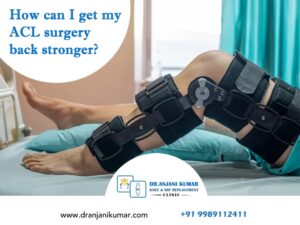Ligament tears, also known as sprains or injuries, involve the stretching or turning of ligaments in the body, which is crucial for joint stability. Common in weight-bearing joints, they can cause pain, swelling, bruising, instability, and limited joint motion. Grade 3 sprains cause significant pain and instability. Seek medical attention for examination, imaging tests, and treatment based on injury severity. Early management promotes healing and reduces long-term complications.
Reasons and causes of ligament tear:
- Trauma or injury: Ligament tears occur from sudden force, impact, or direct blows.
- Sports activities: High-impact athletes risk ligament tears from pivoting, twisting, and sudden changes.
- Overextension or hyperflexion: Joint overstretching can cause ligament damage.
- Repetitive stress: Joint stress weakens ligaments, increasing tear susceptibility in athletes.
- Degeneration changes: Aging causes ligaments to lose elasticity, increasing vulnerability to tears.
- Improper movement mechanics: Improper body mechanics increase ligament stress and injury risk.

- Pre-existing conditions: Hypermobility, collagen disorders, joint laxity, weakened ligaments, causing tears.
- Obesity: Weight gain strains joints and ligaments and increases injury risk.
- Lack of conditioning: Joint muscle weakness increases ligament stress during movement.
- Falls: Falling and landing awkwardly on the knee can cause ligament injuries.
- Car accidents: Car accident trauma can cause knee injuries and ligament tears.
Ligament tears are a common injury affecting knees, ankles, and wrists. Proper warm-up, conditioning, protective gear, and body mechanics can reduce the risk of tears during physical activities. If you suspect a ligament tear or have experienced a joint injury, seek medical attention promptly for proper diagnosis and treatment. Ligament tears are external injuries resulting from external factors, not spontaneously occurring. Early diagnosis and management can prevent further damage and support recovery.
Primary symptoms of ligament tear:
Ligaments support and strengthen joints, ensuring proper alignment and preventing abnormal movements. A ligament tear can cause pain, swelling, bruising, difficulty moving joints, and muscle spasms. Torn ligaments make the joint harder to move and looser than usual, making normal joint movement impossible. Injuries may include a pop or tearing sensation and muscle spasms.
Ligament tear symptoms:
Pain:
- Sudden and severe pain in the knee, especially at the time of injury or immediately afterwards, can indicate a ligament tear.
- When a ligament is torn, it results in damage to the tissue, leading to an inflammatory response.
- Inflammation causes the release of chemicals like prostaglandins and cytokines, which sensitize nerve endings in the area and contribute to pain.
Swelling and pressure:
- The knee may become swollen shortly after the injury, which can persist over time.
- A torn ligament can cause swelling and oedema around the injured area.
- The increased pressure from the swelling can press on surrounding structures, including nerves, contributing to pain.
Joint instability:
- You may experience a feeling of instability or weakness in the knee, making it challenging to bear weight or walk normally.
- A torn ligament can lead to joint instability, causing abnormal movements and increased stress on other structures within the joint.
- This instability can create pain as the joint’s components no longer function balanced and coordinated.
Limited range of motion:
- A torn ligament can limit the knee’s range of motion, making it difficult to fully bend or straighten the leg.
- The loss of stability and range of motion in the knee can result in functional limitations, making it difficult to walk, climb stairs, or engage in physical activities that involve the knee joint.
Bruising:
- In some cases, bruising may occur around the knee joint due to bleeding into the tissues.
- A torn ligament can cause internal bleeding, leading to bruises around the joint.
- It can contribute to localized pain and discomfort.
Muscle spasms:
- In response to the injury, nearby muscles may spasm to protect the injured area.
- These muscle spasms can be painful and further limit the joint’s mobility.
Chemical irritants:
- When a ligament is torn, various chemical irritants are released into the surrounding tissues, which can sensitize nerve endings and lead to pain.
Popping sensation:
- Some people report hearing or feeling a popping sensation at the time of the injury.

Difficulty in walking:
- The pain, instability, and limited motion can make walking or putting weight on the affected leg difficult.
Stretching of nerves:
- When a ligament tears, these nerves can be stretched or injured, triggering pain signals to the brain.
A torn ligament can cause similar symptoms to other knee injuries, so a healthcare professional evaluation is crucial to determine the specific injury and appropriate treatment. Seeking medical attention is crucial to prevent further damage and receive the right treatment. A healthcare provider can perform a physical examination, order imaging tests, and recommend treatments like rest, therapy, bracing, or surgery. The severity of pain varies depending on the extent of the tear, the affected ligament, and individual pain tolerance. Seeking medical attention is essential for proper evaluation, pain management, and a suitable treatment plan for healing and recovery.
The seriousness of ligament tear:
Knee ligament tears are severe injuries affecting the anterior cruciate, medial collateral, and posterior cruciate ligaments. The severity depends on the specific ligament, extent, and individual’s health and activity level.
Impact on joint stability:
- Ligaments play a critical role in stabilizing the knee joint.
- When a ligament is torn, it can lead to joint instability, causing the affected knee to feel weak and give way during movement.
- This instability can impair daily activities and make participating in sports or physical activities challenging.
Pain and discomfort:
- A knee ligament tear can cause significant pain and discomfort.
- This pain may restrict movement and affect the individual’s quality of life.
Functional limitations:
- The loss of stability and range of motion in the knee can result in functional limitations, making it difficult to walk, climb stairs, or engage in physical activities that involve the knee joint.
Risk of further damage:
- An untreated or improperly managed knee ligament tear can increase the risk of further damage to the joint, such as cartilage injuries or meniscus tears.
Long-term consequences:
- In some cases, untreated or inadequately treated knee ligament tears can lead to chronic knee problems, such as osteoarthritis, which may develop over time due to altered joint mechanics.
Impact on physical activity:
- For athletes or individuals with active lifestyles, a knee ligament tear can significantly impact their ability to participate in sports or activities they enjoy.
Treatment for knee ligament tears depends on injury severity, lifestyle, and other factors. Mild tears can heal with conservative treatments like rest, ice, and physical therapy. Severe tears or multiple ligament injuries may require surgical intervention for optimal recovery. Medical attention is crucial to effective management, reducing complications, and improving recovery.
About Dr Anjani Kumar
As an orthopaedic surgeon in Hyderabad, I try to provide patients with as many options as possible for hip and knee treatments to help each patient have the greatest results. I carefully consider the specific sorts of injuries and need to be comfortable offering a specialised solution before recommending the best course of therapy for each patient. My patients’ enhanced mobility and pain reduction are always my top priorities, as these will enable them to resume an active lifestyle. In more severe cases, especially when the joint has collapsed, or the bone has suffered extensive deformation, knee replacement surgery may be advised.
Knee replacement surgery may be recommended in advanced cases, especially if the joint has collapsed or the bone has become severely deformed.
Dr. Anjani Kumar has 20 years of experience and successfully performed 2000 knee replacement surgeries, 350 hip replacement surgeries, and 500 pelvic acetabular surgeries throughout his career. Please get in touch with us on Mobile: at +91 9989112411 and by E-mail: anjanikumar@ gmail.com




